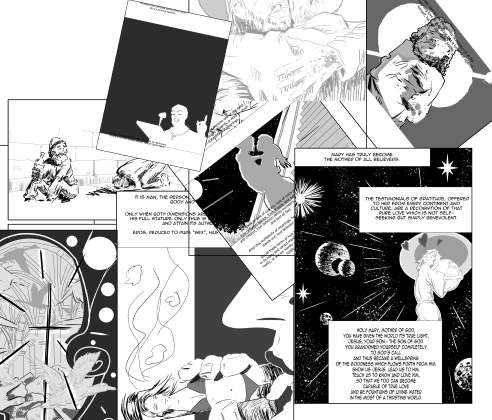Welcome to Deus Caritas Est.
Here you will find resources to pray and use the illustrated encyclicals. This website has two main aspects.
On the one hand there is the catechetical work. On the other hand, the illustrated encyclicals as a means to access the teachings of the Catholic Church.
Catechesis with illustrated encyclicals
The web focuses on the Holy Spirit, who is the One who writes the encyclicals.
In this sense, the role of the Divine Spirit is like when the Europeans discovered the American continent:
– Discovery: Just as a European could not dream of a continent to the west, no one could imagine a Divine Person apart from the Father and the Son.
– Exploration: At the level of flora, fauna and landscapes, the American continent broke the European understandings. And the extent of the land and that there was a culture so different to the West was incredible.
Jesus does something similar: he presents a new earth and a new language. The Illustrated Encyclicals help explore that new land.
The newest thing on this website are the illustrated Vatican documents as if they were comics. The first thing to highlight in them is their trustworthiness to the original document. The text of the illustrated document is the same as that published on the Vatican website. The illustrated Encyclicals are not summaries. Nothing is edited. It is based on a selection of the betters parts of the text.
The only thing that is invented is the illustration that accompanies the text.
When encyclicals and other documents are presented like this, something amazing happens: they are much easier to read. Much easier to read. Exponentially easier.
For example, if Humanae Vitae used to require hours of deep concentration to more or less understand its message, now a few minutes are enough and it is perfectly understood.
A Holy Father who wanted to be different
When a new Holy Father is chosen, he chooses the name by which he wants to be known. There are four names that are repeated a lot in the history of the papacy: John, Gregory, Benedict and Clement.
Interestingly no one has chosen the name Peter and there is no Peter II.
It is also striking that the name of the Pope usually hides an intention behind it.
And since he wanted to focus on the spirit that he encouraged in Asis, he called himself Pope Francis.
Since the name had never been used before, one could just as well say that it is about Francis I.
Encyclicals of Pope Francis
The current Pope has written two encyclicals… and a half. The first of these was an encyclical that was half Benedict, so Francis completed it. The Lumen Fidei.
Its literary value is not up to the level of the immediately preceding ones. And it is that Benedict spoke of Love, Hope and Charity. About one every three years.
And talking about Faith had something of a climax, something definitive. It was the Lumen Fidei after the Deus Caritas Est and the Spes Salvi.
Pope Francis has a closeness to the people that Benedict lacked -and a lot-. But the latter was a wise man with much experience in teaching. For this reason, his encyclicals are expository marvels.
Pope Francis does not reach the level of complexity of John Paul but it is not especially clear in his writings, Benedict type. Still, it’s clear enough on some issues.
He has written the entirety of Laudato Si and Fratelli Tutti. The first highlights ecological conversion and the second human conversion. Neither creation nor others are a means to achieve ends.
pope psychology
Although we do not intend to delve into the reasons that lead the Pope – whom we believe to be especially motivated by the Holy Spirit – to act in one way or another, it seems clear that the Pope wants to listen (and not give answers that do not lead to dialogue) and, at the same time, be anchored in tradition.
Being between the two worlds often gives rise to conflict.
Nothing like Benedict and his unfinished encyclical to highlight the tradition.
But nothing like Laudato Si and Fratelli Tutti to capture much of what worries the Pope.
The Apostolic Letters
Although not as extensive as the apostolic exhortations or encyclicals, there is a Letter that is truly marvelous and is illustrated here: the Patris Corde.
And it is that the character of Saint Joseph is that of a silent saint who lives in the midst of tribulations and of being an outcast and having a hard time… which is the daily bread of many. In addition, his virile character (because he is protective and silent) is admirable.
If we have a heavenly mother, we can also count on the intercession of the one who took care of moving the Holy Family forward. In a cruel world.
The Encyclicals of the Future of Pope Francis
What will the future encyclical be like? That is a good question. The truth is that one is never sure; but I would say that it will go in a specific direction. Where? We think that the Pope is concerned about the commercialization of religion. And it is that religion can be seen as obedience to a series of rules… not the Christian one. The Christian religion is based on the relationship that each one of us has with God. And that relationship does not assure us of anything material – just as it did not assure Jesus a warm and comfortable place to be born.
So it is very possible that the next encyclical will go that way. That is the direction that we think the future encyclical will take. An encyclical in which there is much dialogue. Because in relationships there are no definitive answers and there is a lot of listening. Like the Pope.



